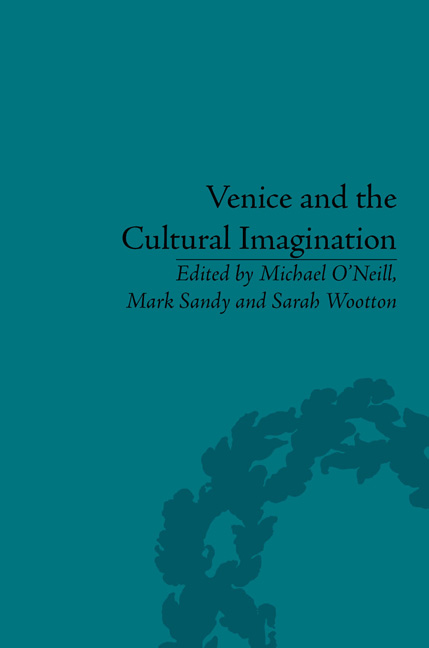Book contents
- Frontmatter
- CONTENTS
- Acknowledgements
- List of Figures
- Notes on Contributors
- Introduction
- 1 A ‘More Beloved Existence’: From Shakespeare's ‘Venice’ to Byron's Venice
- 2 Reimagining Venice and Visions of Decay in Wordsworth, the Shelleys and Thomas Mann
- 3 J. M. W. Turner and the ‘Floating City’
- 4 Venice and Opera: Tradition, Propaganda and Transformation
- 5 Venice, Dickens, Robert Browning and the Victorian Imagination
- 6 ‘The Lamp of Memory’: Ruskin and Venice
- 7 Edith Wharton's ‘Venetian Backgrounds’
- 8 Henry James's Venice and the Visual Arts
- 9 The Myth of Venice in the Decline of Eliot and Pound
- 10 Representations of Venice in Daphne du Maurier's Don't Look Now and Nicolas Roeg's Screen Adaptation
- Notes
- Select Bibliography
- Index
7 - Edith Wharton's ‘Venetian Backgrounds’
- Frontmatter
- CONTENTS
- Acknowledgements
- List of Figures
- Notes on Contributors
- Introduction
- 1 A ‘More Beloved Existence’: From Shakespeare's ‘Venice’ to Byron's Venice
- 2 Reimagining Venice and Visions of Decay in Wordsworth, the Shelleys and Thomas Mann
- 3 J. M. W. Turner and the ‘Floating City’
- 4 Venice and Opera: Tradition, Propaganda and Transformation
- 5 Venice, Dickens, Robert Browning and the Victorian Imagination
- 6 ‘The Lamp of Memory’: Ruskin and Venice
- 7 Edith Wharton's ‘Venetian Backgrounds’
- 8 Henry James's Venice and the Visual Arts
- 9 The Myth of Venice in the Decline of Eliot and Pound
- 10 Representations of Venice in Daphne du Maurier's Don't Look Now and Nicolas Roeg's Screen Adaptation
- Notes
- Select Bibliography
- Index
Summary
Reviewing Edith Wharton's The Age of Innocence in 1920, Katherine Mansfield paints Ellen Olenska as the distillation of European mystery: ‘She is dangerous, fascinating, foreign; Europe clings to her like a troubling perfume; her very fan beats “Venice! Venice!”’ Mansfield, however, remains unstirred: for her, Ellen, and those she disturbs, remain ‘portraits’: ‘human beings arranged for exhibition purposes, framed, glazed, and hung in the perfect light’. When we consider how Edith Wharton herself construes Venice within her broader literary representations of European culture, we find her imagination moving between similar terms. Here, too, figurations of essence, animating spirit, coexist with flatly lifeless scenes: the stiffly arranged human subject, the automaton. In pursuing Wharton's prolonged negotiations with Venice, this chapter will attempt to keep these figures in the foreground.
Such constructions are now familiar in more theoretical models of tourist experience. As John Urry makes clear in The Tourist Gaze, in contemporary debates, while the assignation of relative value to each set of terms fluctuates, questions of ‘authenticity’ remain central: in particular, the line of analysis stimulated by Daniel J. Boorstin's formulation of the ‘pseudo-event’. In Boorstin's schema, tourist experience, mediated through advertising, comes to constitute a ‘closed self-perpetuating’ set of images, generated out of ‘certain approved objects’. Tourists encounter as ‘essence’ of place only prearranged spectacle.
- Type
- Chapter
- Information
- Venice and the Cultural Imagination'This Strange Dream upon the Water', pp. 109 - 126Publisher: Pickering & ChattoFirst published in: 2014



